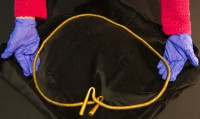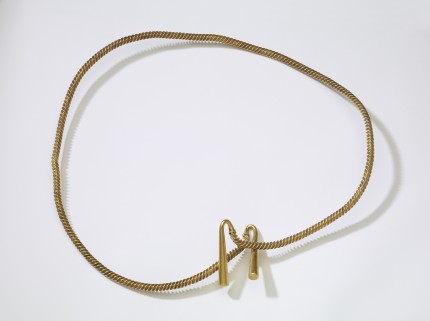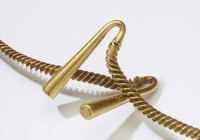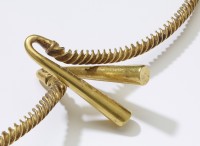 The British Museum just released its annual Treasure and Portable Antiquities Scheme report which announces archaeological findings made by members of the public in the preceding year. Among the whopping 82,272 finds reported in 2015 was a gold torc so huge it defies comprehension. Discovered by a metal detectorist on freshly ploughed farmland in East Cambridgeshire in September of last year, it is a four-flange spiral twisted bar torc dating to around 1300-1100 B.C., the Middle Bronze Age. Not counting the trumpet-shaped terminals at each end, the twisted bar is an exceptional 126.5cm (4’2″) long. The terminals are 108 and 107mm long, so just over four inches each, bringing the total length to more than 4’10”. At 732 grams (1.6 pounds) in weight, it is one of the heaviest bar torcs ever found in Britain and Ireland.
The British Museum just released its annual Treasure and Portable Antiquities Scheme report which announces archaeological findings made by members of the public in the preceding year. Among the whopping 82,272 finds reported in 2015 was a gold torc so huge it defies comprehension. Discovered by a metal detectorist on freshly ploughed farmland in East Cambridgeshire in September of last year, it is a four-flange spiral twisted bar torc dating to around 1300-1100 B.C., the Middle Bronze Age. Not counting the trumpet-shaped terminals at each end, the twisted bar is an exceptional 126.5cm (4’2″) long. The terminals are 108 and 107mm long, so just over four inches each, bringing the total length to more than 4’10”. At 732 grams (1.6 pounds) in weight, it is one of the heaviest bar torcs ever found in Britain and Ireland.
The find site is within 50 miles of Must Farm, the extraordinary bronze age village in the shadow of a chip factory on the edge of Peterborough.
“There was a lot going on in bronze age East Anglia,” said Neil Wilkin, the curator of bronze age Europe at the British Museum, “but it’s been a while since we’ve had anything as hefty as this.”
The torc is of the highest quality in materials and manufacture. It’s made of 86-87% gold and 12-13% silver (the remainder is copper), so 20-21 carat gold by modern standards. The four flanges are between 3.3 and 5mm long and are twisted counter-clockwise so expertly that the gap between them is consistently between 2.25 and 2.5mm for the entire length of the bar. Circular collars are fitted seamlessly between the bar and each terminal. How exactly they were mounted archaeologists haven’t been able to figure out yet, possibly by use of a solder with a different melting point than the gold of the bar and terminals, but tests have found no variation in the gold composition down the entire length of the torc, so if solder was used, it must have been incredibly subtle.
Torcs are usually thought of as jewelry worn around the neck, but unless there was an exceedingly wealthy and stylish Triceratops roaming around Bronze Age Cambridgeshire, this one cannot have been. It couldn’t have even been worn around someone’s waist. Because flange twisted torcs have never been found in burials, archaeologists don’t have any evidence to go on to determine how these giant torcs were worn. Suggestions include that it was worn as a sash, around the body from shoulder to hip, or possibly around the belly of a very pregnant woman as a protective talisman. It may even have adorned sacrificial sheep or goats.
The finder, who has chosen to remain anonymous, did not record the torc as he or she first found it so all experts have to go on is the finder’s vague description of it as “loosely bundled.” It was coiled but someone, and no one is naming names, opened it up into a single large loop and crossed the terminals before the discovery was reported to the Finds Liaison Officer.
The torc was reported to Helen Fowler at a finds meeting at Peterborough Museum, who said she was “gobsmacked” when it came out of the finder’s briefcase. The last torc she had handled was bracelet sized, but this one was far too big to fit on her weighing scales and she had to borrow a box from the museum to take it back to her office.
In addition to making it unwieldy, hard to weigh and materially altering a malleable, delicate archaeological treasure for no conceivable reason, the uncoiling damaged the flanges. In two places — about one third and two thirds along the length of the bar — the flanges are now distorted. In one of the spots, the edges of five twists have been scraped through the outer layer, exposing fresh gold. British Museum experts hope they’ll be able to figure out the original position of the torc at burial by examining the distorted places.
The torc has yet to be valued — a similar but smaller large-scale bar torc discovered in a bog in Northern Ireland in 2009 was valued at £150,000 — but whatever the final assessment, the Ely Museum hopes to acquire it.
Because your friendly neighborhood history blogger would never be so cruel as to report on a freaking huge gold torc without freaking huge pictures of said gold torc, your browser should probably stretch and do some light warm-ups before you click on these:



It would fit comfortably, and loosely, around the base of a large horse’s neck. Perhaps it belonged to a notable warrior’s favorite steed or chariot pony? Depending on how it was twisted, it could also have been an ornamental ‘war bridle’. I don’t know how malleable 21k gold is, but it might have been worn around a war horse’s neck as a kind of protection during battle.
Just a thought.
It’s very malleable, which is one reason why I don’t think it wouldn’t have been used in battle. Too easy to cut it to ribbons. Also, horses were small in Bronze Age Britain, more like today’s Shetland ponies than the massive destriers of the Middle Ages.
I know they were small, but I don’t think Shetland Pony size as much as maybe a Hackney or Icelandic size. The Iceni of a much later period bred the sturdy chariot ponies. Still, a malleable decorative collar would not be out of the realm of possibility. Again, just a thought. It was the only application that made even minimal sense to me.
There are many Bronze Age gold spirals that would clearly have been used as money (‘hack gold’), which clearly is NOT the case with what clearly has the shape of a torque.
My guess would be that this piece is either symbolic for wealth and power, the Bronze Age counterpart of Trump Tower so to speak, maybe the idea behind it is simply that of a very special ingot, or this thing was mounted on some kind of statue, a very important totem tree trunk or something similar (cf. the Old Saxon, Early Medieval ‘Irminsul’).
PS: Freaking huge pictures, freaking awsome blog post(s), by the way. :notworthy:
The shapes of torcs in général, especially this one ´s end forms, are always reminding me of the shimenawa of shintô, sacred cords around temples, trees, sumotori Turned Yokozuna. my visual two cents that’s all.
If it was coiled when found, might it have been worn coiled? That malleable and heavy may have only been used for special occasions.
The coiling makes me think that people back then had a grasp of the screw in principle and application. I realize their has been little evidence of screw application found but…..
“Freaking huge gold torc” sums it up.
I’ve spent quite a bit of time working with heavy gauge wire, cable, and tubing over the years, much of it copper. Copper isn’t as soft as gold, but it’s soft and unforgiving. Rolling out and rolling up sections of copper tubing without distorting it is an art with no reward. Gold of that high purity would be Hell to deal with. Our hero screwed this torq up grandly.
By eyeballing the distortions left from the torq’s original shape, it was in a coil of perhaps three turns w/ those huge terminals left over. Something like that would have likely been wrapped around a form for storage, perhaps a wooden object or totem long rotted away?
So much fun to speculate! So very interesting to hear opinions from metallurgists, artists, historians. Everyone’s suggestions present a plethora of possibilities for this mystery item. I definitely like the idea of it being used on a special tree.
It’s really helpful, too, to have the information Bruce provided. Knowing that it was a coil of 3 turns vs. tightly coiled makes a difference in trying to figure out how it might have been used.
What a beauty! But why do you say it couldn’t have been worn around the waist? 50″ is well within the realm of human girth, pregnant or otherwise. It would probably have been a prosperous person to achieve that size, but that makes sense for the item in question.
Some more ideas, wild speculation and guesswork: There is -even closer than Northern Ireland- the ‘Lambourne Hoard‘ from Berkshire with two ‘twisted bar torcs with flared cylinder terminals’ that look equally similar to the one presented here.
Also, there are Iron Age torcs, and ‘horned gods’ wearing them, depicted on the ‘Pilier des nautes‘ and there is the 1st century BC torc of 7kg, the Silver Ring with rather cute bull’s head ends from the Rottweil Region in Germany, with both bulls (or bull gods?) wearing either ropes -or- torcs around their necks.
To conclude, there might indeed have been statues, trees, statues of animals, and even real ones. There are e.g. traditions of bull sacrifice, but, to give an alternative, each year the cattle, having spent the summer on the pastures, is ritually returned -very alive- to its owners. If cattle is involved here at all, of course. :confused:
Very interesting!! Were the Irish torcs you mention as large as this one? If so, maybe they were used on a prize bull during the summer season and returned to the owner with the torc.
I don’t think the speculation and suggestions are ‘wild’. I find it enjoyable to hear what other history geeks might think about things like this. Everything is speculation until proven. http://www.thehistoryblog.com/wp-includes/images/smilies/thanks.gif
The British Museum curators have posted about torcs, e.g. on how to put them on and about the thing from Northern Ireland, here referred to already, also with interesting comments. Additionally, to follow the Terrible’s tauros theory/i, there is obviously new cattle born on the pastures over the summer, which also is led down in traditional ‘almabtrieb‘ kindergartens. Furthermore, all over Europe there have been Bronze Age golden hats found, indeed without a direct connection to any form of cattle.
The British Museum curators have posted about torcs, e.g. on how to put them on and about the thing from Northern Ireland, here referred to already, also with interesting comments. Additionally, to follow the Terrible’s tauros theory, there is obviously new cattle born on the pastures over the summer, which also is led down in traditional ‘almabtrieb‘ kindergardens. Furthermore, all over Europe there have been Bronze Age golden hats found, indeed without a direct connection to any form of cattle.
(double post, sorry)
Our ‘torc’ could theoretically have been designed to be part of a much bigger structure.
Check out, for instance, the details, particularly the supporting bronze spirals on what is referred to as the Strettweg Cult Wagon from ca. 600 BC.
:hattip:
But those spirals are bronze, where our ‘torc’ is gold. Do you think there would have been a large ceremonial piece made entirely of gold? Not out of the realm of possibility.The more it’s discussed, the more I tend to believe that it was for an animal or, as you point out, some type of very special ceremonial artwork.
To me the way that the twists start with a bend from the end pieces suggests that it was cast/forged as a single piece, and then twisted.
My question is, in the apparent absence of East Anglian gold mines, where did it come from?